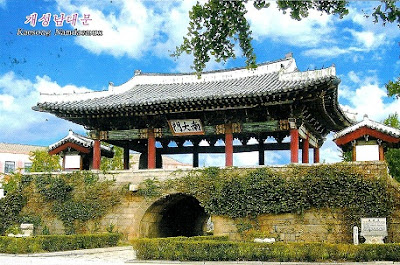A few weeks ago UNESCO added new sites to the World Heritage List. I was lucky to already have 4 of these newly classified sites and over these last weeks, I've received more cards. This one was sent by SL.
With the classification of The Archaeological Heritage of Niah National Park’s Caves Complex, Malaysia has now 5 sites on the WHS list.
This complex of colossal, interconnected caverns is located near the west coast of Borneo Island at the centre of Niah National Park. It contains the longest known records of human interaction with rainforest, spanning at least 50,000 years, from the Pleistocene to the Mid-Holocene periods. The rich archaeological deposits, prehistoric rock paintings and boat-shaped burials found at the northern edge of the massif illustrate biological and human life during this time, and contribute greatly to the knowledge of human development, adaptation and migration in southeast Asia, as well as in a global context. Local communities still observe an ancient tradition of molong – ‘take only what you need’— when harvesting guano and valuable edible bird’s nests from the caves. - in: https://whc.unesco.org
The Great Cave at Niah is truly spectacular both in terms of its enormous size and historical significance. The mouth of the Great Cave is 60 metres high and 250 wide and its floor area covers 10.5 hectares. The cave is accessed from the park HQ by a 3.1 km jungle trail and plankwalk. Archaeological excavations can be see on the left of cave mouth.
From the cave mouth a passage leads to a large chamber at the back known as the Padang. Here rock formations are illuminated by shafts of light that the shine though holes in the cave roof. Beyond the Padang is a dark passage called Moon Cave (Gan Kira).
From the cave mouth a passage leads to a large chamber at the back known as the Padang. Here rock formations are illuminated by shafts of light that the shine though holes in the cave roof. Beyond the Padang is a dark passage called Moon Cave (Gan Kira).
The Great Cave has a long history of human settlement. In 1950s and 1960s Niah was the focus of intense archaeological research with excavations led by Tom Harrisson, the curator of the Sarawak Museum, and his wife Barbara. The Harrissons and their team found evidence of long term human occupation and burial. Earthenware, ornaments, bone tools and food remains were found in the caves. Their most notable find was a human skull.
The skull was found in 1958 in the West Mouth of the Great Cave. The skull belonged to an adult female. Radiocarbon dating of the charcoal found at the same level of the dig, suggested the skull was 40,000 years old. This made it the oldest modern human fossil known at that time. - in: https://borneoadventure.com
%20-%20C%C3%B3pia.jpg)
%20-%20C%C3%B3pia.jpg)
.jpg)
%20-%20C%C3%B3pia.jpg)

%20-%20C%C3%B3pia.jpg)
.jpg)
%20-%20C%C3%B3pia.jpg)
%20-%20C%C3%B3pia.jpg)
%20-%20C%C3%B3pia.jpg)

.jpg)


.jpg)
.jpg)
.jpg)
.jpg)
.jpg)
%20-%20C%C3%B3pia.jpg)
.jpg)
%20-%20C%C3%B3pia.jpg)
%20-%20C%C3%B3pia.jpg)
%20-%20C%C3%B3pia.jpg)
%20-%20C%C3%B3pia.jpg)
%20-%20C%C3%B3pia.jpg)






.jpg)
.jpg)

.jpg)